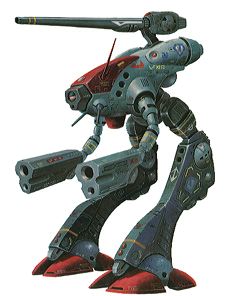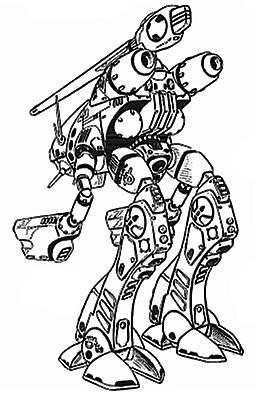

Designation:Glaug Battle Pod |
|
||||

|
|||||
| Length : | 10.0 m |
| : | 11.4 m (Including upper gun barrel) |
| Width : | 8.0 m |
| Height : | 18.1 m |
| Weight : | 41.2 metric ton |
Note: all plasma-shock expansion engined draw their plasma from a single fusion pile.
(*) Terran designation. The Tirolian designers considered the sensors part of the design and did not assign separate designations for these systems.

The armor of the Glaug is composed of an advanced titanium-steel alloy. The armor stops all small arms and heavy infantry weapons fire, provides reasonable resistance to light mecha-mounted weaponry, such as the Zentraedi 22.3mm HE autocannon round, and poor resistance to medium mecha-mounted weaponry, such as the Valkyrie's 55mm APFSDS round.
The Glaug provides full protection from nuclear, biological, and chemical hazards, using a sealed cockpit environment. The internal consumables supplies can provide breathable atmosphere for four days maximum.
The higher-ranking field commanders in the Zentraedi army were all issued a Glaug command battle pod. This mecha was even more mobile than the Regult series, and the Glaug also had the advantage of heavier weaponry and armor. All this was in accordance with Zentraedi military practice, which equipped officers and higher commanders with more robust equipment in general, to the point that these individuals even differed in having a far more robust physical structure. At the extreme end of this spectrum, Zentraedi fleet commanders often were so large as to no longer fit inside the mecha they commanded.
The Glaug had two arms, ending in double-barreled weapon pods. This gave the weapons mounted there better fields of fire and increased training and elevation rates. In addition, the Glaug mounted a long-range particle beam cannon of almost thrice the power of a hand gun on the torso, and two medium autocannons were fitted below the particle beam guns on the arms. To compensate for the recoil of these weapons in space, a dedicated thruster was fitted to the rear of the weapon hands. Almost as an afterthought, two light autocannons, mostly for anti-personnel use, were mounted in the chin. Finally, six small missiles were fitted in front of the cockpit, but these proved to be of limited usefulness and many Glaug sortied without loaded missile tubes, to reduce (incoming) fire hazards.
The Glaug usually led groups of Regult on the ground, but could also be equipped with a booster, much as the REF's Alpha fighter could be equipped with a Beta as booster, to turn the essentially ground-based mecha into a transorbital fighter. This booster, the Glaug Armored Vehicle, also had some extra weapons built in: 144 Maggot Universal Dogfight Missiles. However, both the Glaug and the Regult could function as space fighters, though not as aerial fighters, without the benefit of extra boosters. Also, both mecha could 'swim' short distances underwater; although the armament could not be used when submerged, approaching a target underwater when possible and then emerging nearly on top of the objective was a favored Zentraedi tactic.
The Glaug entered service in the middle years of the 19th century, and remained in production at least until 2015 in some parts of the Tirolian Mercantile Empire. The replacement for this mecha was, in fact, designed and production had started, but this new mecha, the Relaug battle pod, never entered service in any meaningfull numbers.
Return to Zentraedi Mecha Index.
Go to Robotech Reference Guide Home Page.
Robotech (R) is the property of Harmony Gold. This document is in no way intended to infringe upon their rights.
Content by Pieter Thomassen, with Peter Walker and Rob Morgenstern